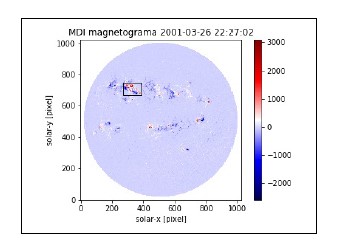Resumen
Las regiones solares activas, y los procesos que en ellas ocurren, han sido estudiadas y analizadas ampliamente y se han elaborado muchos tipos de modelos y caracterizaciones de los distintos eventos eruptivos que tienen lugar en la atmósfera solar. Las regiones más características son aquellas que tienen polaridad magnética opuesta y que, en su mayoría, generan eventos explosivos, como las denominadas fulguraciones solares. Las fulguraciones son intensas explosiones que suceden en la atmósfera solar, que pueden llegar a tener efectos adversos sobre la Tierra y la tecnología desarrollada por el ser humano, además de ser determinantes en el llamado clima espacial, por lo cual se ha intentado predecir su aparición. En este estudio se desarrolló un modelo predictivo de fulguraciones solares de clase mayor a M5 con base en los propuestos por Korsos, et al. (2014, 2015), utilizando la relación existente entre las fulguraciones y las regiones activas bipolares. En el análisis se tuvieron en cuenta las áreas de las umbras de las manchas solares de polaridad opuesta, su campo magnético promedio y los baricentros de cada una de estas manchas en una muestra de tres regiones activas. Como resultado se generó un modelo predictivo encontrando la variación temporal de cantidades relacionadas con los baricentros magnéticos que se produce por la evolución de las manchas solares, con lo que se confirmaron resultados previos consignados en la literatura. Se hizo un análisis estadístico para inspeccionar si después de una fulguración, puede tener lugar otra en las horas siguientes.
Referencias
Collins, C. (2013). Astronomy 101: From the Sun and Moon to Whormholes and Warpdrive, Key Theories, Discoveries, and Facts about the Universe, 1st ed. USA: Adams Media. p. 39-40.
Korsos, M.B., Ludmány, A., Erdélyi, R., Baranyi, T. (2014). Pre-Flare Dynamics of Sunspots Groups. The Astrophysical Journal. 789: 107.
Korsos, M.B., Ludmány, R., Ludmany, A. (2015). On Flare Predictability Based on Sunspot Group Evolution. The Astrophysical Journal. 802: L21.
Korsos, M. B., Yang, S., Erdélyi, R. (2018). Investigation of Pre-Flare Dynamics Using the Weighted Horizontal Magnetic Gradient Method: From small to major flare classes. Journal of Space Weather and Space Climate. 9: A6
Moreno-Cárdenas, F., Cristancho-Sánchez, S., Vargas-Domínguez, S. (2016). Advances in Space Research, The Grand Audrolume, 1 January 2016. 57 (1): 257-267.
Domingo, V., Fleck, B., Poland, A.I. (1995). SOHO: The Solar and Heliospheric Observatory. Space Sci Rev. 72: 81-84.
Robitaille, T., Tollerud, E., Greenfield, P., Droettboom, M., Bray, E., Aldcroft, T., Streicher, O. (2013). Astropy: A community Python package for astronomy. Astronomy & Astrophysics. 558: A33.

Esta obra está bajo una licencia internacional Creative Commons Atribución-NoComercial-SinDerivadas 4.0.
Derechos de autor 2020 Revista de la Academia Colombiana de Ciencias Exactas, Físicas y Naturales

